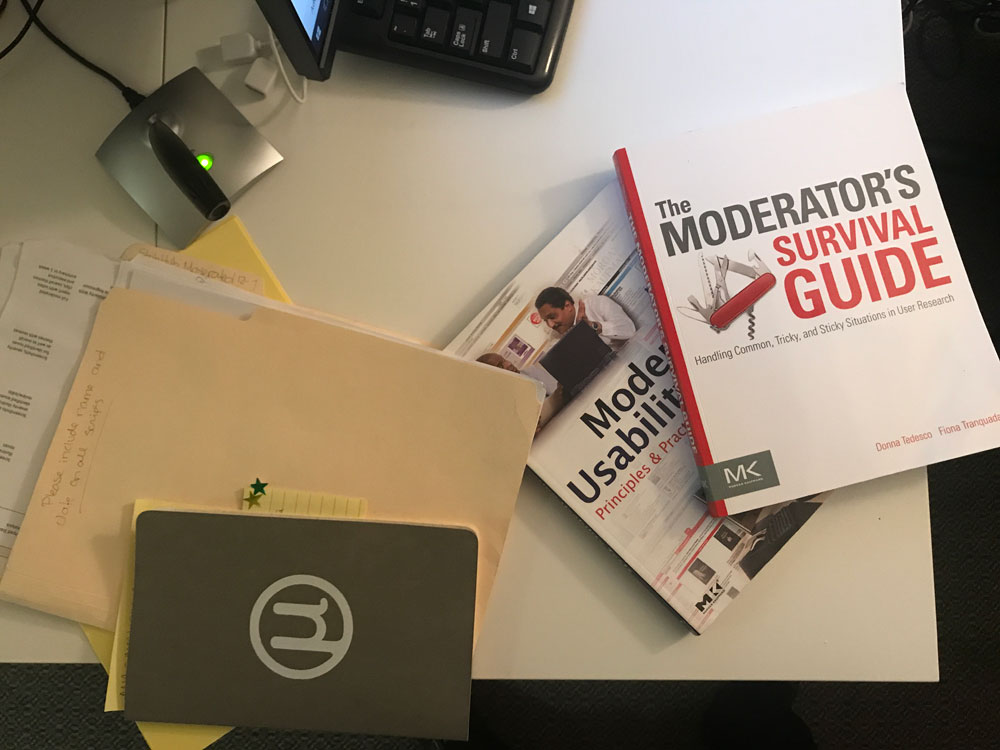
Facilitating a usability test is a skill.
With enough of the right practice you’ll get better at facilitating and running more effective usability test sessions.
A solid foundation in both the theory and practical applications of facilitating a usability test will aid you in becoming a solid facilitator.
To help, here are ten resources for both beginners and intermediate usability test facilitators.
1. Read about the technique of usability facilitation.
While the best learning for facilitating comes from doing, it’s good to have a foundation in the techniques of facilitating. An excellent place to start is Dumas and Loring’s Moderating Usability Tests.
2. Understand the history and evolution of thinking aloud.
Having participants think aloud as they use an interface is a cornerstone technique of usability testing. To better understand both the method and how to best apply (or not apply) it in a usability test, it helps to know where think aloud came from and how it’s evolved, and even how it may affect a participant’s behavior.
3. Refine these five core techniques of facilitating.
- Reduce or avoid using “why” questions.
- Try not to plant ideas in the minds of the users.
- Minimize yes and no questions.
- Don’t rely too heavily on the “would you?” questions.
- Gently deflect questions back on the user to understand what they think (not you).
4. Know the ten golden rules of facilitation.
- Adjust interaction based on the purpose of the study.
- Respect participants’ rights to stop at any time, ask questions, and speak up if they feel uncomfortable.
- Let participants struggle (but know when to assist).
- Remain in charge.
- Be professional.
- Let the participants talk.
- Intuition can hurt and help.
- Remain neutral and minimize bias.
- Don’t reveal info accidentally.
- Monitor and manage your performance.
5. Learn when to provide assistance.
While the idea of assisting participants seems contradictory to the major goal of usability testing (letting people use the product without help), intervention is warranted at times. When a participant is really struggling for a long time, study time is running out, or when a major problem needs to be avoided, a facilitator should assist. Knowing when to refrain and when to assist is a balancing act that takes practice.
6. Have a survival guide.
Things don’t always go as planned. From no-shows to late, untalkative, and uncooperative participants, you should be prepared to know what to do. The Moderator’s Survival Guide includes great advice on what to do when things go wrong and how to prevent problems.
7. Modulate your style.
Learn to adjust the style based on the goals of the study.
Babysitter: For performance-focused and scripted studies, the facilitator is often there to be sure the study runs smoothly.
News Reader: More than a babysitter but still short of a lot of intervention from the facilitator.
Investigative Reporter: The facilitator acts similar to an investigative reporter when a session is scripted with notes, questions, and hypothesis, but may need to deviate from the script from time to time to answer questions and explore behavior.
Teacher: When there is a guide or rubric rather than a script, the interaction can be similar to a teacher following a lesson plan.
Therapist: When there’s not a script or guide, only broad research questions, the facilitator needs to act as a therapist. In this role, the facilitator probes comments to uncover root causes, which allows participants to go deep into topics.
8. Know when to talk and not talk.
Sitting quietly in a room with another person and watching them struggle isn’t natural, or always comfortable. Silence though is often golden to uncover issues or watch how participants proceed without influence. But you need to know when to talk and when to answer a participant’s question. Our friends at Nielsen Norman Group suggest the Echo, Boomerang, and Colombo techniques.
Echo: The facilitator repeats the last phrase or word the user said, while using a slight questioning tone.
Boomerang: A generic, nonthreatening question that the facilitator can use to push the user’s question or comment back to him.
Colombo: The facilitator starts part of a question and trails off, rather than asking a thorough question.
9. Take some training.
Look to continually hone this skill by practicing and taking training courses. David Travis at Userfocus has some good material on facilitating a usability test.
10. Continually look for ways to improve.
Here are twenty tips to help make your study go smoothly, including over-recruiting, backup plans, and recommendations on how to take notes, track usability problems, and collect metrics to generate more effective usability test reports.


